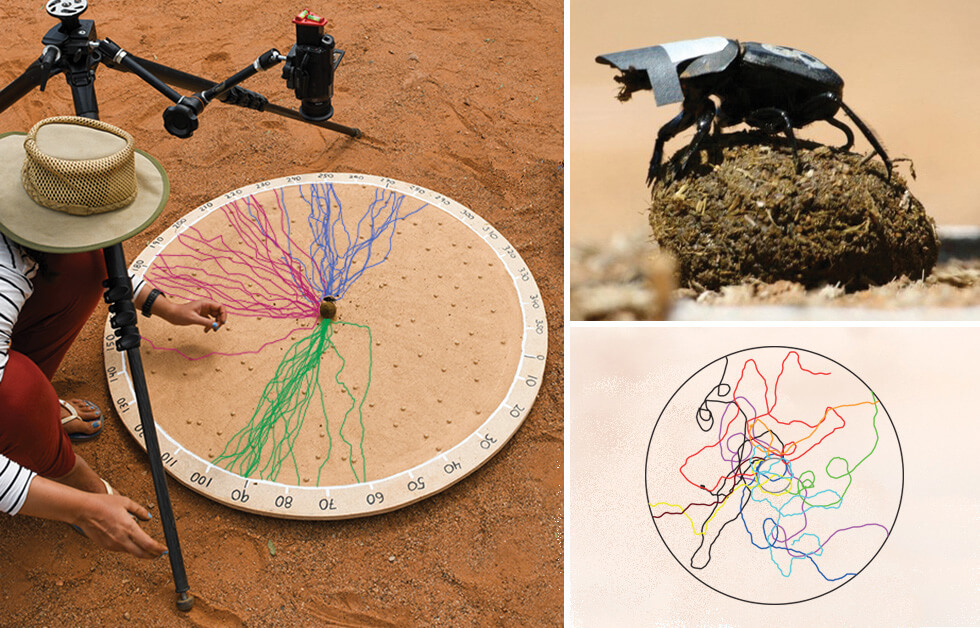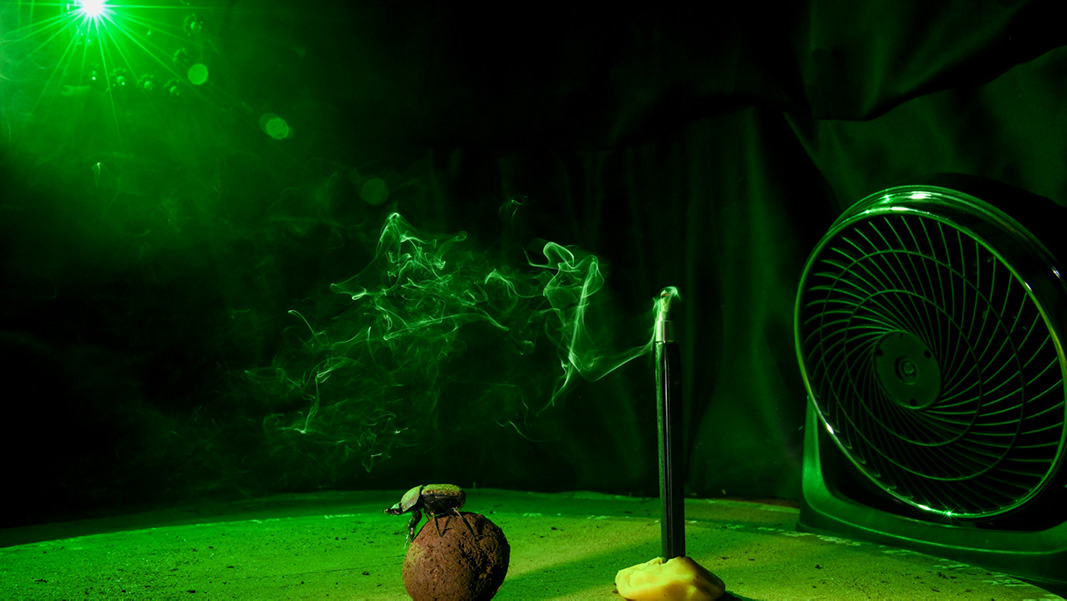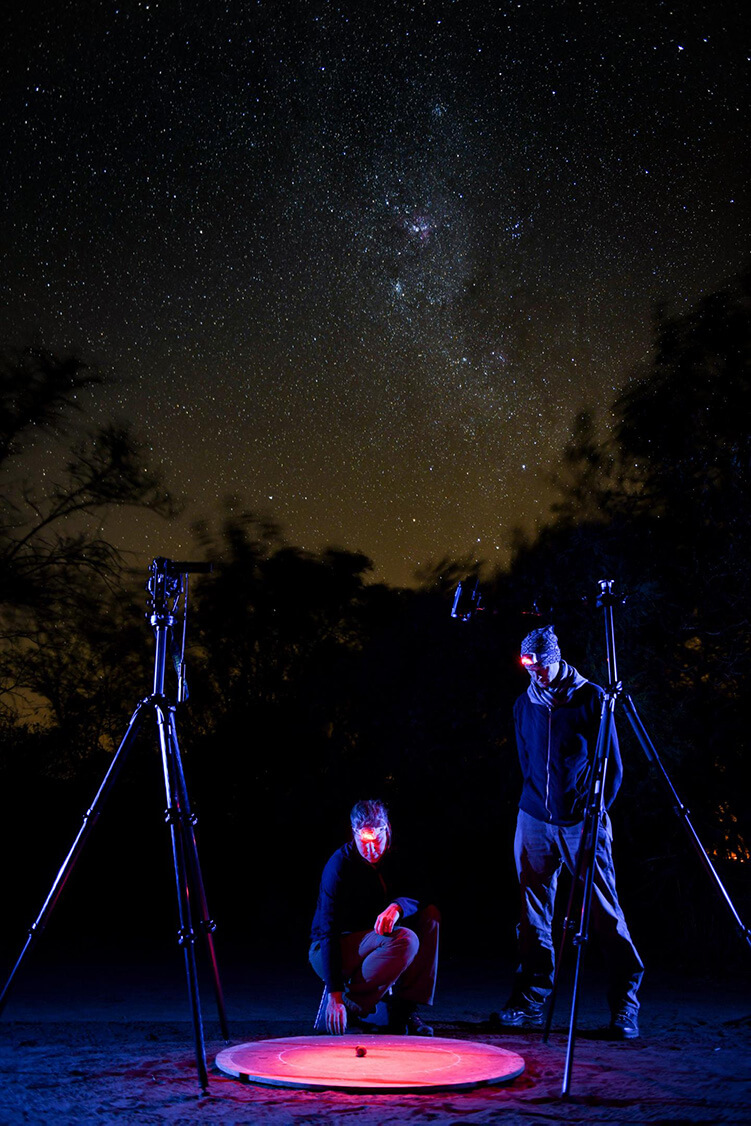Placed over the heart in the wrappings of Egyptian mummies, archaeologists have often found carved amulets of scarab beetles, a species of dung beetle. The amulets, many with spells inscribed on them, were intended to help the dead in a final judgment by the jackal-headed god of death, Anubis, who would weigh the hearts of the deceased to assess whether they were worthy of the afterlife.
The ancient Egyptians also believed that a dung beetle drove the movement of the sun, because the sacred scarab (Scarabaeus sacer) — which sculpts dung into balls for meals, gifts for potential mates or repositories for eggs — rolls the balls across the ground in a manner that reflects the sun’s journey across the sky.
In fact, it’s the sun that steers the movement of dung beetles. And so does light from the moon, and from the distant stars of the Milky Way. With a life devoted to excrement but guided by the heavens, dung beetles might embody the famed Oscar Wilde quote, “We are all in the gutter, but some of us are looking at the stars.”
“Tiny brains can solve fantastic tasks,” says neurobiologist Marie Dacke of Lund University in Sweden, one of a small cadre of researchers who have worked for years, often as a team, to piece together the tricks the insects use to roll balls in their eerily straight lines.
The best escape
Roughly 600 of the 8,000-plus known dung beetle species roll such balls, scurrying away from mounds of animal dung with spheres of excrement for about six minutes before they bury the balls, along with themselves, so they can dine underground in peace. (Many more species don’t roll balls, but stow dung away in long tunnels burrowed directly under dung pats.)
To keep their cargo from getting stolen by rivals, ball rollers have evolved to escape from dung piles in the fastest, most efficient way possible — a straight line, as the scientists describe in an article in the Annual Review of Entomology.
“In South Africa, elephant dung is just alive with dung beetles — you can find hundreds or even thousands of dung beetles in a dung pile, and they’ll happily smash each other up to steal a ball,” says neuroethologist Eric Warrant at Lund University. “The last place they’d want to end up is back at the dung pile with all the others, so they’ll roll in a straight line in any direction, as fast as they can.”

A researcher measures the impressively straight paths that three species of dung beetle (indicated by different-colored lines) navigate when rolling balls of dung from the center of a circle (left). When dung beetles wear light-blocking caps (top right), the ability to roll straight is disrupted (bottom right). Such experiments reveal that dung beetles use a variety of light sources as directional cues.
CREDITS: M. DACKE ET AL / AR ENTOMOLOGY 2021 (LEFT AND BOTTOM RIGHT); MARCUS BYRNE (TOP RIGHT)
But traveling in a straight line is surprisingly difficult. A 2009 study found that human volunteers in a German forest and in the Sahara Desert repeatedly plodded around in circles when they could not see the sun, and blindfolded participants walked in circles as small as 20 meters wide. Without a point of reference, the paths that people and other animals take can easily drift from straight to spiral, due to factors such as uneven terrain.
Remarkably, dung beetles keep straight even though they can’t see where they are going while rolling. They propel their balls with their hind legs, moving backwards with heads pointed at the ground (bringing to mind the quote of how dancer Ginger Rogers did everything her renowned partner Fred Astaire did, save backwards and in high heels).
As far back as the fifth century, Egyptian scholar Horapollo described the beetle’s movement as rolling its ball from east to west, while looking east. Remarkably, it took until 2003 for Horapollo’s observation to be confirmed. When entomologist Marcus Byrne at the University of the Witwatersrand in Johannesburg, along with Dacke, Warrant and others, placed five species of dung beetles in little arenas on farmland in South Africa, the creatures usually rolled dung balls in the direction of the sun. But when the team reflected the sun off a mirror while hiding the real sun from view, the insects followed the reflected sun instead. Similar responses are seen in the lab when using an LED as an artificial sun, Dacke says.
Rolling, rolling, rolling: Dung beetles of the species Canthon violaceus (Olivier) from the Dominican Republic maneuver a ball of dung over rough terrain.
CREDIT: JONATHAN SAHULA
Going with the wind
But what happens around noon when the sun is at its zenith, halfway between sunrise and sunset, making it an unreliable cue for distinguishing east from west? A 2019 study revealed that the South African dung beetle Scarabaeus lamarcki can rely on the wind instead. “We believe they’re detecting the wind via their antennas,” Dacke says.
This strategy makes sense at the edge of the Kalahari Desert, where these insects live. The wind there blows strongest when the sun is at its highest, driven by heat rising from the land after a morning’s baking.
In experiments, neuroscientist Basil el Jundi at the University of Würzburg in Germany, with Dacke, Byrne and their colleagues, placed a pair of table fans facing each other across a ball-rolling arena. When one fan blew, the dung beetles rolled their balls in a variety of directions. But when they switched to the other fan, each insect typically rolled its ball in the opposite direction from before. In other words, the precise direction the wind is blowing doesn’t seem to matter to the insects — what matters is that it blows constantly, in mostly the same direction, for the six or so minutes that the insects roll their balls before burrowing into the ground, helping them keep a straight course.
And the beetles ignore the wind entirely as a navigational cue when the sun is not directly overhead. “They have all these fallback mechanisms — if one system fails, they can switch over to another,” Byrne says.

In addition to light, some species of dung beetle can use the wind as a cue to help them roll their dung balls in straight lines, as revealed by experiments using table fans. This allows the beetles to roll straight even when light cues are absent, such as when the sun is high or the day is cloudy.
CREDIT: CHRIS COLLINGRIDGE
Guided by moonlight
Sun and wind work very well as cues for dung beetles that are active during the daytime. But a few of the ball-rolling species are nocturnal. For them, a 2003 study revealed that guiding light can ripple from the moon.
Light waves can ripple up and down, left and right, or at any angle in between. But when light from the sun or moon strikes tiny particles in the atmosphere, some of it gets polarized: The waves ripple in the same direction. Scientists know that bees, ants and many other insects can orient themselves using polarized sunlight, but dung beetles are the first known to orient themselves using the million-times-dimmer polarized light that emanates from the moon.
Dacke, Byrne, Warrant and their colleagues noticed that the nocturnal African dung beetle Scarabaeus zambesianus could roll in straight lines on moonlit nights but not on moonless ones. To figure out if these insects depended on the moon’s position or the polarized light that it emits, the researchers used a board to hide the moon from view, though its light was still visible in the night sky. They next placed a polarizing filter over the insects to rotate the rays of moonlight 90 degrees. This made the beetles turn abruptly — showing that polarized light was the orienting cue.
The Milky Way shows the way
But the moon isn’t out every night. What then? Another potential cue came to Byrne and colleagues one night in 2007.
“After a great day’s work, the moon goes down, and we’re sitting and having a beer under the beautiful desert sky of the Kalahari, and there’s the Milky Way,” Byrne recalls. “And one of us said that, if we can see that, they must be able to see that.”
And they do. Although the insects’ eyes are too small and weak to navigate from single stars, a 2013 study revealed that they apparently see the brighter, wide band of light that the Milky Way draws across the night sky. In experiments with the dung beetle Scarabaeus satyrus under the simulated night sky of the Johannesburg planetarium, Dacke, Byrne, Warrant and colleagues found that the Milky Way’s path could steer the insects’ course — making dung beetles the first known animals capable of orienting themselves using this cue.
This presented a puzzler, however, since the researchers had earlier observed that the insects meandered on moonless nights. But when the worried scientists reviewed their notes, they found that these earlier experiments took place in months when the Milky Way was too low in the night sky for the beetles to see it.

Nocturnal dung beetles can use not just moonlight but the light of the Milky Way to guide their path when rolling dung balls, field experiments have revealed.
CREDIT: CHRIS COLLINGRIDGE / WITS UNIVERSITY
By the sky only
One set of cues that dung beetles don’t rely on for navigation are landmarks or anything else on the ground. “We’ve created arenas with high walls and a 30-centimeter opening, and we thought, ‘OK, guys, solve this one, there’s only one way to get away from the dung pat’ — and they fully ignored it,” Dacke says.
In another study, the scientists filled half the arena with dung beetles tied to the floor. One might imagine that beetles rolling their dung balls would steer clear of their tethered brethren — “but no, they just rolled over the tied-down beetles,” Dacke says.
The scientists conducted still other experiments in which dung beetles wore broad-brimmed cardboard caps so they could not see the sky. The haberdashery caused the beetles to roll around in circles, “fully lost,” Dacke says — confirming their dependence on celestial cues. Since they don’t have permanent nests, instead regularly moving from one ephemeral dung pat to another, memorizing landscapes may not prove useful when they spend their life wandering about, says neuroethologist Emily Baird of Stockholm University.
Wonders of tiny brains
Though much has been learned about the dung beetle’s tricks and traits, there’s a lot more still to understand. “It never fails to surprise me how complex insects can be,” Baird says. “We’re looking at these tiny animals with brains the size of poppy seeds that use the sun and the wind to guide them ... We have these massive brains, and we still don’t yet understand how these small brains work.”
As far as scientists can tell, dung beetles are the only animals to use visual cues for orientation but ignore landmarks, Baird says. She and Dacke are comparing dung beetle brains with those of beetles that do use landmarks for navigation to learn more about how these complex behaviors evolved.
And to shed light on the neural circuits dung beetles use for orientation, Dacke, el Jundi and post-doctoral researcher Cody Manchester aim to record signals from neurons as the creatures roam the African savannah — using tiny electronic backpacks connected to the beetles’ brains. “These beetles are very, very strong, one of the strongest animals for their body size, so they’re very useful to attach things to,” Dacke says.
The scientists also want to learn more about a strange dance the dung beetles do after they’ve rolled up their balls of dung: mounting the ball and, for a few seconds, gyrating on top before climbing down and setting off with the ball. This dance may help the insect take a snapshot of the sky’s features at the start of its journey, to match with its view of the heavens as it moves, in order to maintain a straight path. “It’s a very elegant strategy,” el Jundi says.
Understanding how these insects can solve complex navigational tasks might help computers use as few computations as possible to perform similar feats, the scientists speculate. Byrne notes that a $1 million cash prize was offered in the DARPA Grand Challenge, which had autonomous vehicles drive a desert course more than 200 kilometers long — weighed down with cameras, proximity sensors and GPS.
“The more we can learn about dung beetles,” he says, “the more we can maybe get tiny robots to behave in a similar fashion in completely unknown landscapes.”




